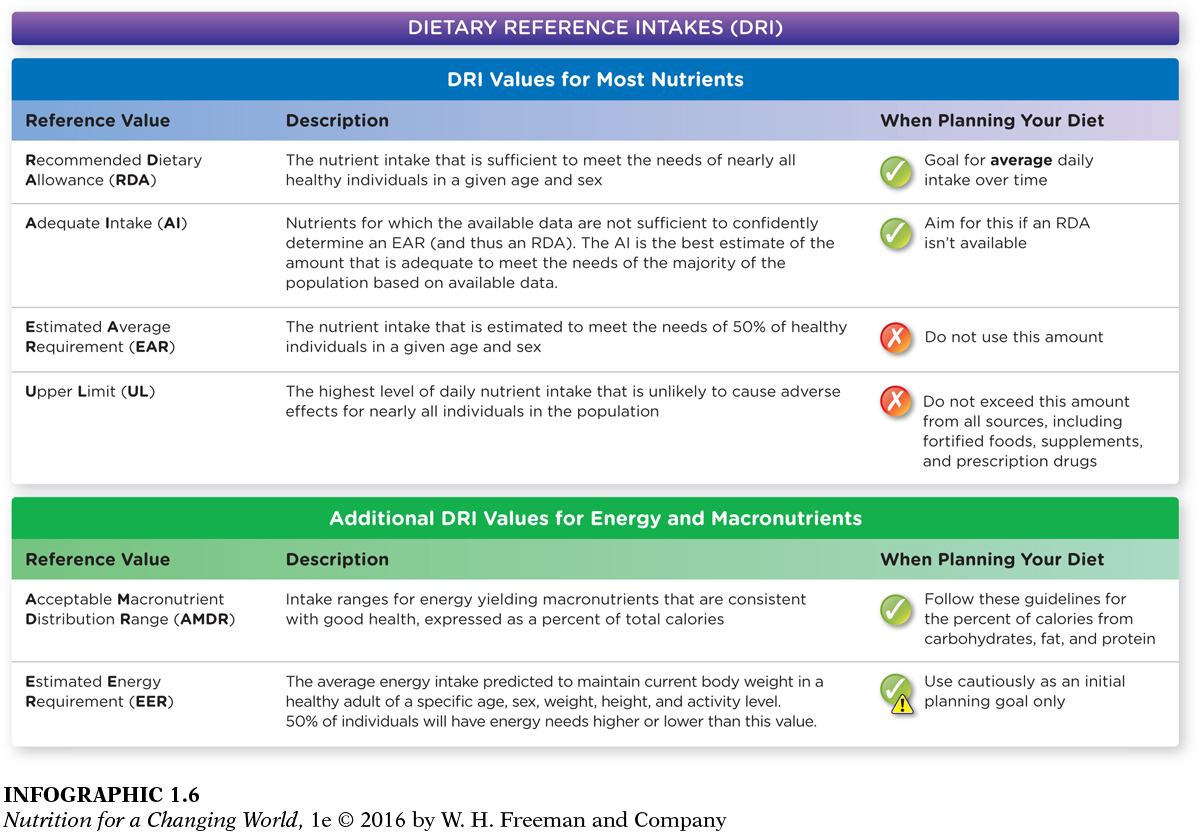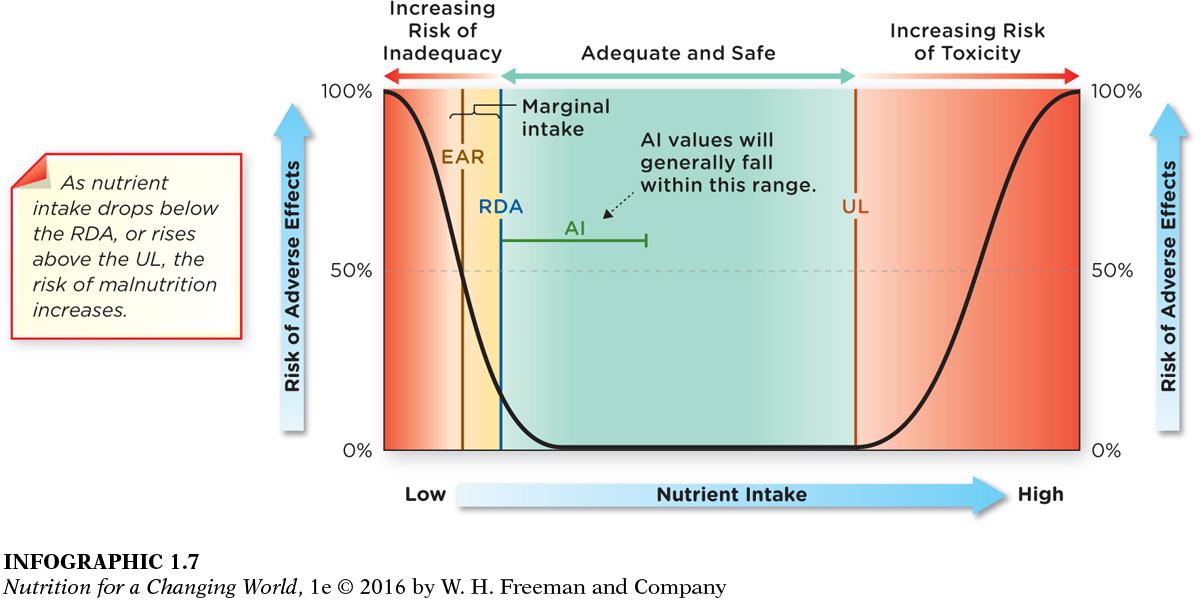NUTRIENT INTAKE RECOMMENDATIONS
A question just as interesting as the role of nutrition in early life is the one you may frequently ask yourself: How do I know I’m getting enough nutrients? To help us choose the foods that create a healthful diet, the Institute of Medicine—
DIETARY REFERENCE INTAKES (DRI)
reference values for vitamins, minerals, macronutrients, and energy that are used to assess and plan the diets of healthy people in the United States and Canada
The DRI recommendations for nutrient intakes include four values. (INFOGRAPHIC 1.5) The first is the Estimated Average Requirements (EARs), which capture the average amount of a nutrient needed by sex and age group. As such, this is an intake that meets the needs of 50% of individuals within that group. But these are not recommendations for each individual, as half of the population would be eating less than they need at this level of intake. Rather, the EARs are used to assess the nutrient adequacy of populations, and are the first step in setting the DRI recommendations.
ESTIMATED AVERAGE REQUIREMENT (EAR)
the average nutrient intake level estimated to meet the daily requirements of half of the healthy individuals for the different sexes and life-

Question 1.5
 What reference value provides information to help us avoid excess consumption of nutrients?
What reference value provides information to help us avoid excess consumption of nutrients?
The Tolerable Upper Intake Level (UL) value provides information to help us avoid excess consumption of nutrients.
To establish the second set of values, a safety factor is added to the EAR to create the Recommended Dietary Allowance (RDA), so that the RDA represents the average daily amount of a particular nutrient that meets or exceeds the requirements of nearly all (97% to 98%) healthy individuals.
RECOMMENDED DIETARY ALLOWANCE (RDA)
the recommended nutrient intake levels that meet the daily needs and decrease risks of chronic disease in almost all healthy people for different sexes and life-
When there is insufficient evidence to generate an EAR for a nutrient, the RDA for that nutrient cannot be set and the committee establishes the third set of values: the Adequate Intake (AI) value, based on research or observations of the amount of the nutrient individuals typically need. For example, the B vitamin called folate has an established RDA, but the recommended intake for biotin, another B vitamin, is currently provided as an AI.
ADEQUATE INTAKE (AI)
estimated value for recommended daily nutrient intake level used when there insufficient evidence to determine a specific RDA
Because store shelves are now overflowing with food and supplements that supply extra amounts of nutrients, the DRIs also set safe limits of nutrients with its final set of values: Tolerable Upper Intake Levels (ULs), which represent the highest amount of a specific nutrient that most people can consume daily without causing any harm. As research evolves, existing DRIs are modified, and new DRIs for additional nutrients are created. DRIs have been set for macronutrients, micronutrients, electrolytes, and water. (INFOGRAPHIC 1.6)
TOLERABLE UPPER INTAKE LEVEL (UL)
the maximum amount of nutrient allowed that has been proven to have no risk of side effects

Question 1.6
 What three reference values provide recommendations for nutrient intake that we should strive to achieve?
What three reference values provide recommendations for nutrient intake that we should strive to achieve?
The three reference values that we should strive to achieve are the Recommended Dietary Allowance (RDA), Adequate Intake (AI), and Acceptable Macronutrient Distribution Range (AMDR).
Putting these all together creates a more complete picture of each nutrient. For example, for adult women and men the EAR for vitamin A is 500 micrograms per day (mcg/day) and 625 mcg/day, respectively; the RDA is 700 mcg/day and 900 mcg/day, respectively; and the UL is 3,000 mcg/day for both sexes. Deficiency or excess of vitamin A can injure the human body. Deficiency impairs immune function, and leads to night blindness, and eventually permanent blindness. At the other end of the spectrum, intakes of vitamin A above the UL cause liver disease and can cause serious birth defects. (INFOGRAPHIC 1.7)

Question 1.7
 What are the two causes of malnutrition shown in this figure?
What are the two causes of malnutrition shown in this figure?
The two causes of malnutrition shown are nutrient intakes below the RDA or AI and nutrient intakes above the UL.